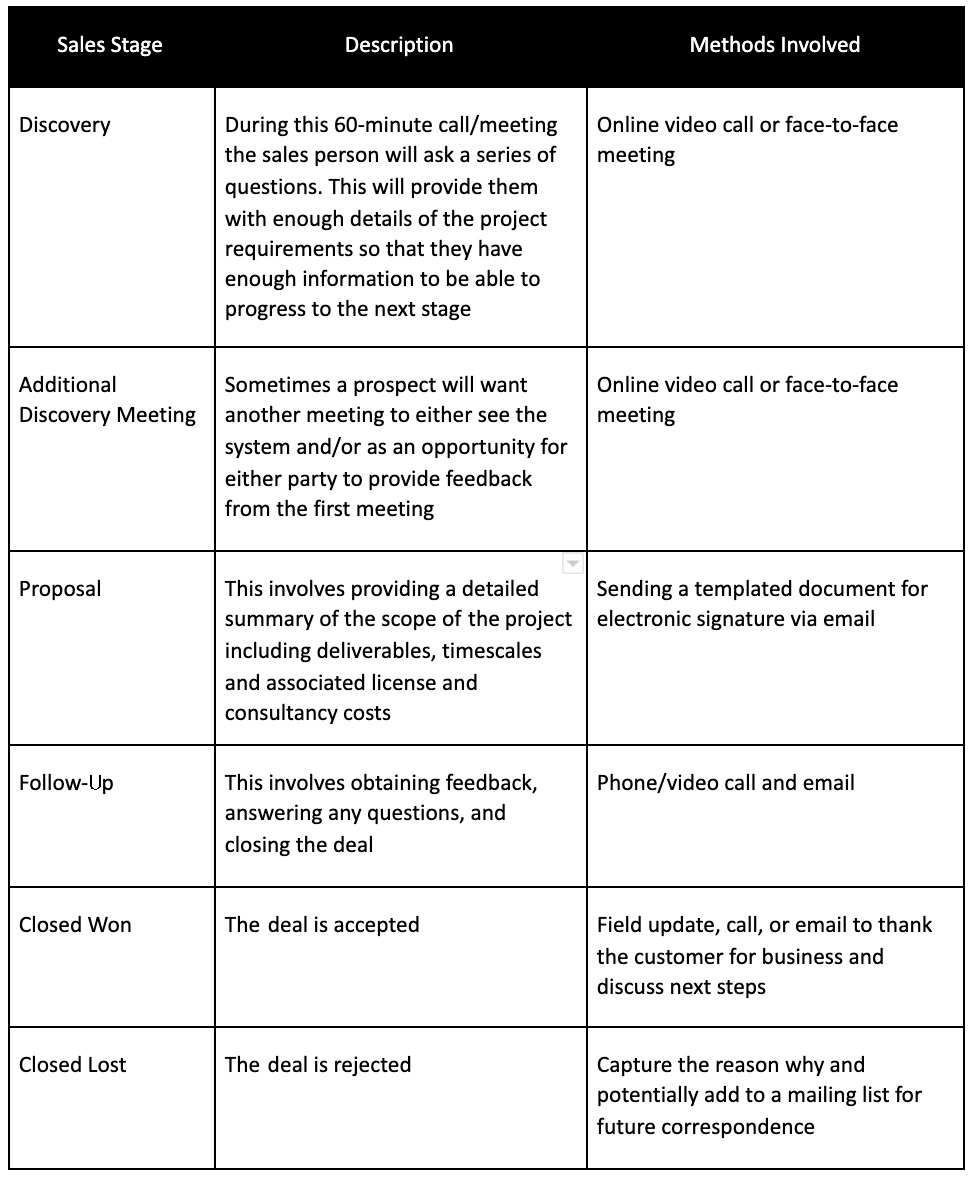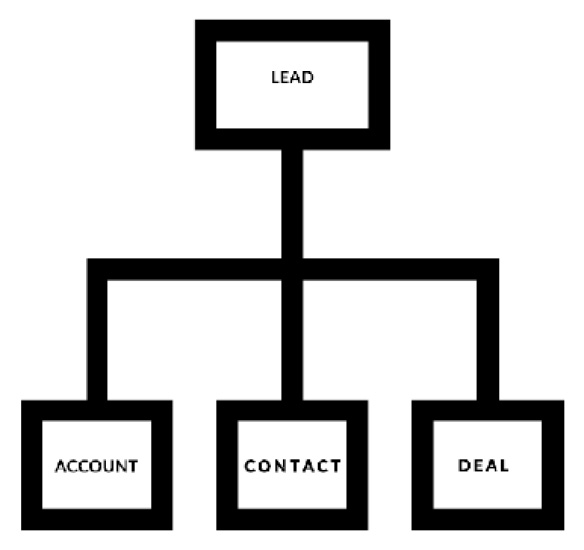Introducing the foundation modules – Leads, Deals, Accounts, and Contacts
Firstly, let's consider the foundation modules and understand why they are named as such. When designing and building any structure such as a house, extension, or other building, it is critical that we include solid foundations to build upon. Failure to do this results in a structure that will not be fit for purpose or one that will not be long-standing.
The same is true of a CRM system and Zoho. We have four foundation modules, listed as follows:
- Leads
- Deals
- Accounts
- Contacts
In this section, we will discuss each of these modules, explaining the difference between them and the importance of using these modules correctly. Not knowing the difference between these modules is actually one of the biggest mistakes new users make—this often leads to building a system in the wrong way, meaning that for some, they may never truly realize the full potential that Zoho has to offer their business.
Let's start by looking at Leads.
Leads
A lead in Zoho can be defined as an unqualified contact or sales opportunity in your business.
In the Leads module, we must capture all the information needed to help qualify a contact/possible opportunity as quickly and effectively as possible.
In short, the information we need to record in the Leads module is who, what, how, and why they have contacted us/we have contacted them, which can be detailed as follows:
- Who: The contact name and name of the organization (if business-to-business, or B2B)
- What: The nature of their inquiry; which product(s) or service(s) they are interested in
- How: The method by which they have contacted us—such as by phone or email; through the company website; via social media; referral
- Why: For what reason have they contacted us and made this inquiry
Once we have recorded the key data as per the preceding outline, the next important question to consider is: How do we qualify a lead?
While this varies from business to business and sector to sector, there are a few lead qualification methodologies/tools that can and should be applied—for example, BANT (Budget, Authority, Needs, and Timeline), SCOTSMAN (Solution, Competition, Only Me, Timebound, Size, Money, Authority, Need), or CHAMP (Challenges, Authority, Money, and Prioritization). To help decide which one will be a good fit for your business, a useful blog on this subject can be found here: https://contactbase.net/sales-qualification-frameworks/.
Once you have selected or adapted one that is a good fit for your business, then it is very useful to include fields that prompt our sales team with the best qualification questions to ask in our Leads module.
In Chapter 2, Leads – Getting It Right the First Time, you will learn how to add fields to capture all of the information discussed so far. So, let's now consider what happens once a lead has been received and recorded.
Tip
Capturing where the lead came from will provide us with the ability to understand which lead-generation activities generate the most leads, and of these leads, which generate the most revenue. Acting on these insights will have a significant positive financial implication on your bottom line. See Chapter 15, Building Actionable Reports and Dashboards (CRM), for further details on this.
Following up on leads
Once a lead is received and key information recorded, it is important to have a simple, clear, and well-defined follow-up process in place for you and the team to follow. The following table describes a typical process to consider:

Table 1.1 – Following up a lead
As the Leads module is the starting point of our CRM journey for our new customers, it is also the first impression our users will have upon using the CRM itself. It is therefore very important that we consider that the user experience (UX) in this module will help define how they perceive and subsequently use the system in later modules. In short, creating a great first impression with users in the Leads module will have a significant impact on how well they use the CRM overall.
Once we have successfully qualified our lead, it is time to look at what happens next in deals.
Deals
A deal is a qualified lead. If deal is not the correct term for you, don't worry—you can easily rename this to suit. Indeed, many users change this to potentials, opportunities, or whatever fits best within their business.
Tip
A useful glossary provided by Zoho can be found at https://help.zoho.com/portal/en/kb/crm/getting-started/articles/understand-crm-account#Key_CRM_Terminologies.
Deals can be defined as the business deals that generate revenue for your organization with other organizations (B2B) or with people (business-to-consumer, or B2C). A deal evolves through different sales stages such as Qualified, Discovery, Quote, and so on, before it is actually a deal, lost or won. Leads can be directly converted to opportunities that represent a potential sale.
The Deals module encapsulates your sales process. It will provide you and your team with the ability to view how many deals are in the pipeline, which stage each one is at, and what the potential value is. It also allows a sales manager to prepare an accurate revenue forecast.
Quite simply, when built and used correctly, this module transforms businesses and can provide an incredible platform for them to grow.
In Chapter 3, Deals – Sales Funnels to Fuel Your Business Growth, you will learn how to build your Deals module. However, before you do, it is important to define what the sales stages are that the sales team must go through in order to convert each deal into a sale in your business. Here are some sample sales stages:

Table 1.2 – An example sales process
In Figure 1.2, we can see that our process has a distinct beginning, middle, and end. It avoids jargon and abbreviations and as a result, it should be simple and intuitive to follow. When defining your stages, ask yourself: Would a new starter in my business understand when to apply each stage and what to do? If the answer is Yes, then your process is intuitive.
Tip
List the stages that, when followed, will provide the most effective way to process a potential deal until it is closed won or closed lost within your business. Validate this with other sales managers or leaders in the organization to obtain early buy-in from these key stakeholders and influencers.
Accounts
When converting a lead in Zoho, it will create a record in the Accounts module.
Accounts are the companies or departments within companies within which you have business dealings, often described as your customers.
This module will contain all of the organizational details that are needed for us to secure, retain, and service their business. The data recorded here will give us greater capability when it comes to reporting and gaining a deeper understanding of the demographics and traits of our customers.
How you create, manage, and use this module will have a significant impact on the success of your CRM. An Accounts module managed well will provide your business with the basis of accurate and insightful reporting. This will help you to fully understand not just what is happening right now, but the trends and progress being made to assist with the predictions and planning of future growth. In Chapter 4, Accounts and Contacts – The Beating Heart of Your CRM, you will learn how to set up this module effectively.
Contacts
When converting a lead in Zoho, it will also create a record in the Contacts module.
Contacts are the people within the companies with which you have business dealings.
It is quite common and often recommended that these contacts also include suppliers, partners, referral partners, and other types of contacts with which you need to build and maintain relationships.
The Contacts module is key also when integrating with other Zoho and third-party applications such as Campaigns, Surveys, SalesIQ, and Emails, as people engage with your team using these channels.
How you create, maintain, and use the Contacts module will have a huge impact on how successful communication with your contacts will be. Successful communication helps to build trust, and increased trust builds stronger relationships. Stronger relationships help your business to grow, and this growth will be more sustainable. Learn how to best set up your Contacts module in Chapter 4, Accounts and Contacts – The Beating Heart of Your CRM.
Important note
The relationship between Accounts and Contacts in Zoho is one-to-many. Within one account (company) you may be dealing with several contacts (people), all of which will have their own record in Zoho. The benefit of this is that we can plan and track communication individually yet still have a summarized view within the Accounts record.
Having learned about each of the foundation modules individually, it's time to summarize them.
Recapping on the foundation modules
So, now you understand the importance of each of the four individual core modules of Zoho CRM, it is useful to visualize the relationships between them. The following diagram illustrates this:

Figure 1.1 – Converting a lead
The general rule that is applied here is that when a lead is Qualified, it is converted into three records: Accounts, Contacts, and Deals.
With this knowledge and by setting our modules up to follow this process, everything should click into place, and we will understand how we can design our system in a way that gets the most out of the structure and functionality of Zoho CRM.
It is worth noting that new users sometimes challenge the difference between a lead and a deal. Why not just use one module and have it all in the Deals module? This is not an uncommon question.
The answer to this lies in the fact that not all inquiries will ever be qualified and, as it is only the Qualified leads that will turn into actual business deals and generate revenue,it is critical that we measure the number of leads that do/do not qualify and also make sure that our sales team are focusing their efforts in the right places (such as qualified ones).Quite often in businesses with a sales team, we find that one part of the team will be following up on inquiries, qualifying them, and booking appointments for one of the senior members of the sales team or the field sales representatives. Thus, splitting unqualified and qualified into two separate modules in Zoho lends itself perfectly to this process and division of labor and activity.
The second benefit of this approach is that we are not populating our Accounts and Contacts modules with lots of unqualified leads that will never progress, which in turn helps maintain the integrity and also the value of our database.
In Chapter 2, Leads – Getting It Right the First Time, we will explore the Leads module in a lot more detail; however, for now, it is useful to digest and understand that for most of our new business inquiries, this is the way we will process them in Zoho using the four foundation modules.







































































